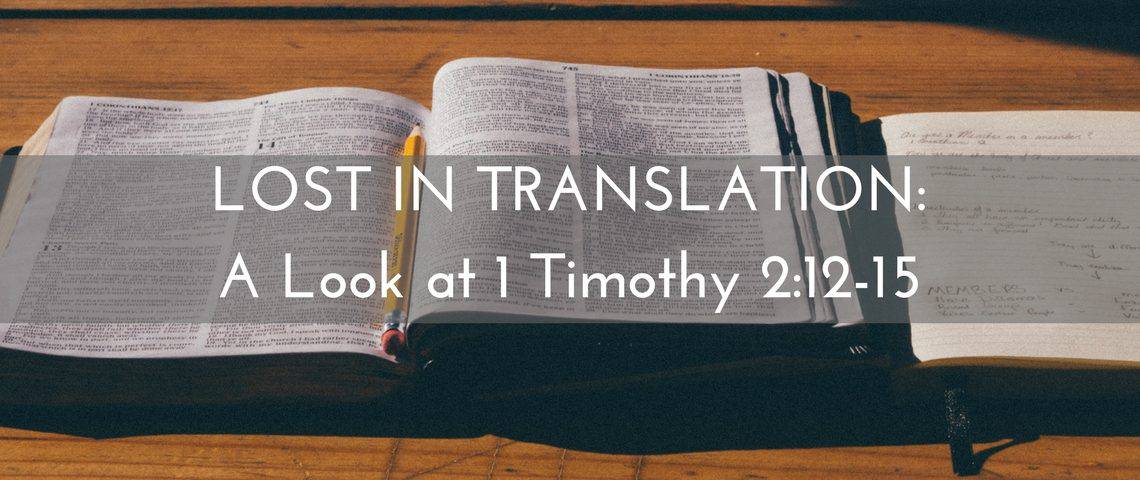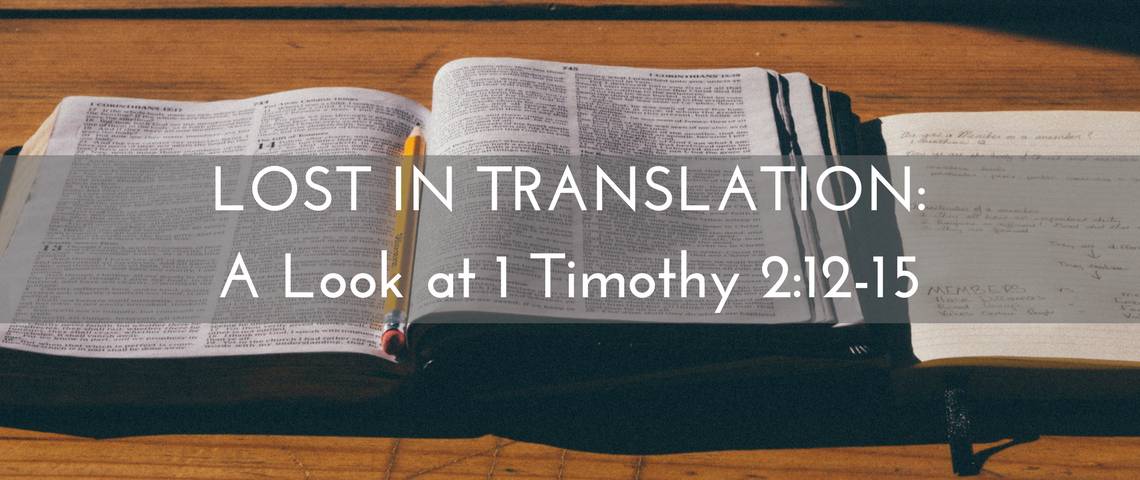In Lost in Translation, Part 1, Bob showed that some words in the Bible are translated differently when they refer to women as opposed to when they refer to men. Case in point: Phoebe’s depiction as servant and helper rather than minister and leader. Today he addresses the impact of translation on our understanding of 1 Timothy 2:12-15.
So, what went wrong?
In the 4th century A.D. the church became the state religion of the Roman Empire. It may be said of this merger that Christianity altered Rome. I think it may be equally said,however, that this merger altered Christianity, and not for the better.
Gender bias in translation did not begin with the English language; it started in the 4th century, when St. Jerome helped to translate the Bible into Latin (the Vulgate). Words took on new meanings, and passages that might put women on equal footing with men were altered, in some cases subtly, in others more dramatically.
In the Vulgate version we find the first change in the translation of “prostatis”.1 Jerome was a man of his times; in other words, a very patriarchal Roman. He had a negative view of women and is quoted as saying, “a wife is classed with the greatest evils”. 2 Not a very Christian sentiment, but a very Roman one. During the Punic Wars, for instance, Rome blamed women for their defeats, in much the same way as Nazi leaders blamed Jews for the defeat of Germany in World War I. Women were the scapegoats of the Empire, and strictly subjugated to male authority.
1 Timothy 2:12
It was also Jerome who significantly—and for all time since—altered the meaning of 1 Timothy 2:12. This passage allegedly prohibits women from teaching or leading men in the church. Thanks largely to Jerome’s example, a key verb here (authentein) has been translated “to exercise authority”. In Jerome’s time, it was rendered more in terms of “having dominion over” or “dominating” a man. Prior to this, the word more commonly referred to the instigation or commission of an act of violence, suicide or murder. In the Greek Septuagint, for example, a noun form of the word (authentas) refers to those who engaged in ritual violence in the worship of a false god.3
In Timothy’s time and locale, the goddess Cybele (called Artemis by the Greeks) was worshipped through violent rituals against men that symbolized the murder/suicide of a false god named Attis4 . In his letter to Timothy, Paul repeatedly warns against false doctrines, mythology and extreme forms of self-denial (1 Timothy 1:3-7, 4:1-5, 6:20-21), referring to the false teaching and related practices as “demonic”. The violent act symbolizing the death of Attis was indeed an extreme form of self-denial. Male priests of Cybele and Attis renounced all sexual feeling, irrevocably, through ritual castration.
Prior to Jerome’s translation, 1 Timothy 2:12 would probably not have been understood as a prohibition against female authority. It is more likely–given the most common usage of “authentein,” the nature of Paul’s concerns, and the context of the letter—that it is a prohibition against women teaching or instigating ritual violence against men.5
Saved through Childbearing?
1 Timothy 2 also discusses the salvation of women in “childbearing” (v.15). Jerome believed that women literally received salvation in Christ by bearing children.6 His belief utterly contradicts the New Testament gospel message of salvation by grace through faith in Jesus Christ alone. Most Christians today reject his interpretation of childbirth, but for some reason continue to uphold his interpretation about women in the church. (More on “saved through childbearing” here.)
In contrast to Jerome’s views, in Miletus, just south of Ephesus, Artemis was worshiped as the goddess who “saved” women should they die in childbirth.7 Rather than worship a false goddess, Paul encourages women worried about dying in childbirth to receive salvation through “faith, love, and holiness” (v. 15). All Christians, men and women, are saved by faith that is expressed through love and holiness. We also know that in the creation myths of Artemis and Attis, the female deity was portrayed as the source of all life and goodness, and the male deity as the source of evil.8 In contrast, Paul quotes the creation account from Genesis, in which Adam is a source of life and Eve plays a role in humanity’s fall (v. 13).
The nature of Paul’s concerns, the most common meanings of the verb “authentein,” and the religious and cultural context in which these verses were written are all lost in Jerome’s Latin translation of 1 Timothy 2:12-15. Subsequent translations into German and English followed this example.9 Concerns about false teaching and violent rituals were replaced with warnings against women.
So, does the Bible tell us that men may lead and women may not? Does it tell us that men may teach and women may not? The Greek New Testament does not tell us these things.
In its original language and context the Bible does not teach this, anywhere.
If you’d like to know more about this difficult passage, we have a great article for you on our Resources page.
References:
1McCabe, E. (2013). A reexamination of Phoebe as a “Diakonos” and “Prostatis”: Exposing the inaccuracies of English translations, Retrieved from: http://www.sbl-site.org/publications/article.aspx?articleId=830
2Wijngaards, J. (2013). St. Jerome Against Jovinianus, Book 1 § 27-28, Retrieved from http://www.womenpriests.org/traditio/jerome.asp#burden
3Wilshire, L.E. (2010). Insight into two biblical passages: Anatomy of a prohibition 1 Timothy 2:12, the TLG computer, and the Christian church. Lanham, MD: University Press of America, Inc.
4Ferguson, J. (1970). The religions of the Roman Empire. Ithaca, NY: Cornell University Press.
5Edwards, B. (2013). Let my people go: A call to end the oppression of women in the church, Charleston, SC: Createspace.
6Wijngaards, J. (2013). St. Jerome Against Jovinianus, Book 1 § 27-28, Retrieved from http://www.womenpriests.org/traditio/jerome.asp#burden
7Farnell, L.R. (1977). The cults of the Greek states: Volume II. New Rochelle, NY: Caratzas Brothers, Publishers.
8Ferguson, J. (1970). The religions of the Roman Empire. Ithaca, NY: Cornell University Press.
9Wilshire, L.E. (2010). Insight into two biblical passages: Anatomy of a prohibition 1 Timothy 2:12, the TLG computer, and the Christian church. Lanham, MD: University Press of America, Inc.





27 responses to “Lost In Translation: A Look at 1 Timothy 2:12-15”
Hi Liz, my apologies for the delay in responding. Life has been quite eventful lately. A complete list of references is available in my book here: http://www.amazon.com/dp/B00DV2JRHQ
To be immediately helpful, I can tell you that a book by A.R. Favazza called “Bodies Under Siege” looks at ascetic cults in Asia Minor (e.g. Cybele/Artemis/Attis) and demonstrates their apparent influence on the practices of the Roman church, including celibacy and even self-castration for priests.
St. Augustine and St. Jerome describe their own views on women and sexuality extensively in their own works. Both viewed sexual passion as sinful in and of itself. Both advocated celibacy, and viewed it as a prefered state to marriage. Sexual activity even in marriage should be done without passion, they thought, and only for the purpose of procreation etc..
I had access to their works from a local University where I served as a Clinical Supervisor. Excerpts from the works of the “early church fathers” can also be found online. One site I found helpful is womenpriests.org. Another is earlychristianwritings.com.
Wilshire’s book, “Insight into Two Biblical Passages” discusses the impact of the works of Jerome and Augustine on Bible translation very well. I also enjoyed Raming’s book entitled “A History of Women and Ordination, Volume 2.”
That’s a fairly short list of available resources, but hopefully that will give you a nice start :). Best wishes with your own studies!
Bob, thanks for much that providing this list – I would say you have gone above and beyond in sharing these resources. The book by Favazza looks intriguing. Going to take a look at it on Amazon!
Bob, I’m intrigued by your research and have just dived into the same subject.
Where did you find the information about the Roman church and connection to celibacy?
I’m just aware that it’s a commonly used linguistic device–a particular favourite of Shakespeare :).
I think it helps us recognize that Paul is warning us about teaching “something.” The something is contained in the infinitive verb authentein, which most commonly meant: to instigate violence, to support violence, to commit murder, to commit suicide, to perpetrate a violent crime, or to slay with one’s own hand. An English rendering of the Greek expression found in 1 Tim. 2:12 could include the following possibilities, “I do not permit a woman to teach or to support (or to commit, or to perpetrate, or to instigate) violence against a man.” What is she not to teach, support, instigate, commit or perpetrate? Violence.
I’m persuaded that this is likely ritual violence as practiced by the priests of Cybele in and around Ephesus. The priests were called “Essenes.” A Jewish sect in the same area of the world, during the New Testament era, was also called by the same name (Essenes), and observed similar practices. Specifically, both groups emphasized extreme forms of self-denial (forbidding marriage and abstaining from certain foods, see 1 Timothy 4:3). They then claimed that this ascetic lifestyle gave them access to special revelation from their chosen deity. The Essenes of Artemis and Cybele would prophesy in a trance-like state. The Essenes of Judaism claimed that their asceticism gave them a special understanding of God’s law (see 1 Timothy 1:7). They also claimed that their unique understanding of God’s law was authoritative on the basis of being descended from the Levitical priesthood (i.e. they were preoccupied with genealogies, see 1 Timothy 1:4).
It does not seem that Paul is concerned in his letter about women in general. He repeatedly makes reference to the beliefs and practices of ascetic cults that were prevalent in and around Ephesus; and their practices did indeed include ritual violence against men, as a part of their extreme self-denial.
Furthermore, history appears to demonstrate that Paul’s concerns were justified. Shrines dedicated to Cybele (the mother of the gods) were taken over by the church, and dedicated to the virgin Mary (who became known as the mother of God). It wasn’t long before the church adopted asceticism (celibacy) as a requirement for priests, and some of them literally practiced castration to renounce their bodily passions (e.g. Origen). Ironically it was this ascetic leadership in the church of Rome of the 4th century (e.g. St. Jerome, Bishop Augustine) that re-envisioned 1 Timothy 2:12 as a warning against female authority, rather than a warning against ascetic cult teachings—teachings they themselves had already embraced. The more I researched this topic, the more troubled I became. The relevant history here is disturbing, and in my experience, largely unknown.
Thanks so much Gail for sharing that information on hendiadys. A very helpful perspective :).
You’re welcome. I was realizing, though, that I didn’t list a citation for that. I think it was Dr. Bilezekian, but not in his book – a lecture, maybe. I will try to track it down and send it to you. Or maybe someone else knows something about this???
Hi Whit, I think the prohibition is against teaching something harmful (e.g. authentein in the original sense of the word), not against teaching in general.
Throughout the letter, Paul expresses concern about false teaching, demonic teaching, mythology, extreme asceticism etc.. In other words, “false” teaching is the object of his concern, not “women” teaching.
Having said that, Paul is likely to address women in this portion of his letter. Cybele/Artemis was a deity primarily worshiped by women, and called upon by women “in travail.” If anyone was teaching “authentein” in the oldest, most common sense of the word, it would likely have been women in the Ephesian congregation.
I think it is very helpful to reflect on Paul’s stated concerns to Timothy, the religious context of the letter, and the original language. When these elements are not factored into our translation and interpretation, isolated words can be taken out of context and understood as stand-alone generalizations. (I think that’s what St. Jerome did, for example, in his interpretation of verse 15; hence, the error regarding salvation in childbearing.) The evidence persuades me that these kinds of generalizations about women were not Paul’s intended message.
I sincerely appreciate your scholarly research in understanding the usage of the term that’s translated, “to exercise authority over.” So how do we understand the first part of the verse in that context? As far as I understand it, the original Greek does prohibit teaching.
Whit, I am so glad you asked that question! I have done quite a bit of research on the Greek used in this passage and learned that many scholars believe the verb “didaskein” used here for “to teach” is linked to the verb “authentein” in what is called a hendiadys – a linguistic term for the expression of a single idea by two words connected by a conjunction.
In English an example would be “don’t eat and run” – the prohibition here is not about eating, but about eating and then leaving quickly. In fact eating is wanted and not prohibited. So a better interpretation of this verse might be “Don’t teach in a domineering way”.
There are a lot of other issues in this passage, including a switch from the plural for women to singular for this portion you’re wondering about and back to plural again, but that’s the subject for another post!
As my 80 year-old dad (a retired Baptist pastor and missionary) said the other day, “boy, there sure are a lot of problems with that 1 Timothy 2 passage, aren’t there?”
Wow–thanks so much for another illuminating post, Bob! I’m learning so much from your writing. I can’t wait to point people to this post when they bring up this verse.
I’m glad you found it helpful Ariel :). I also think it’s great that you can share the information with others, especially if these verses are misused to the detriment of women and the gospel.
Thank you for sharing the link Peggy. I think any perspective that takes an interest in the original language as used in the original context is going in the right direction. Blessings to you sister!
Interesting. My latest post was on this very text!
http://abisomeone.blogspot.com/2013/08/abi-paul-timothyand-subtle-humor.html
Just goes to show that there is so much going on that we just don’t know. So many possibilities…none of which have to be against women!
I love the paraphrase you suggest in your post, Peggy! I’ve read several before, but this pulls together everything I’ve read on the chapter. Thank you so much for sharing it – I highly recommend that everyone click on that link – worth the time!
Thank you, Gail — and Bob — for your kind words of encouragement. I have been on this trail for 33 years. There is so much subtle communication that blows right past us, it is exciting to see clues from time to time. I am content … until the Spirit provides the next bit of insight! Be blessed….
Here is a glance at Wilshire’s research related to the meanings of the Greek word “authentein” as used in Greek literature between the years 200 B.C. and 200 A.D.. The New Testament era is the intentional center of this range:
-Polybius used the word authenten, 2nd century B.C., to mean the “doer of a massacre.”
-The word authentian is used in III Macabees, 1st century B.C., to mean “restrictions” or “rights.”
-Diodorus Siculus used three variations of the word (authentais, authenten, authentas), 1st century B.C. – 1st century A.D., to mean “perpetrators of sacrilege,” “author of crimes” and “supporters of violent actions.”
-Philo Judaeus used the word authentes, 1st century B.C. – 1st century A.D., to mean “being one’s own murderer.”
-Flavius Josephus used the words authenten and authentas, 1st century A.D., to mean “perpetrator of a crime” and “perpetrators of a slaughter.”
-The apostle Paul used the word authentein once during the same time period as Diodorus, Philo and Josephus. [I believe, therefore, that it likely had a similar meaning, particularly given the Ephesian context we have just examined.]
-Appian of Alexander used the word authentai three times, and the word authenten twice, 2nd century A.D., to mean “murderers,” slayer,” “slayers of themselves” and “perpetrators of evil.”
-Sim. of the Shepherd of Hermas used the word authentes, 2nd century A.D., to mean “builder of a tower.”
-A homily by Pseudo-Clement used the word authentes once, ? A.D., to mean “sole power.”
-Irenaeus used the word authenias three times, 2nd century A.D., to mean “authority.”
-Harpocration used the word authentes, 2nd century A.D., to mean “murderer.”
-Phrynichus used the word authentes once, 2nd century A.D., to mean “one who murders by his own hand.” (Wilshire, 2010, p. 28)
Whereas the word authentein was used on rare occasions (e.g. by Irenaeus) to denote authority, it was much more commonly used to indicate something violent, murderous or suicidal.
A significant shift in meaning is found by the 4th Century in Rome, largely in the work of St. Jerome and John Chrysostom. St. Augustine’s commentaries further emphasize this shift in meaning to one of “exercising authority.”
I thought this information might make a helpful supplement to the post :). Those interested in studying this subject in more depth might enjoy some of the books listed as references (see above).